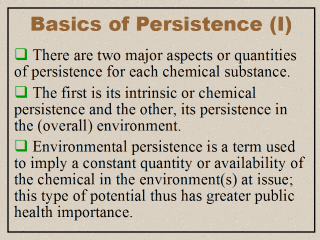| front |1 |2 |3 |4 |5 |6 |7 |8 |9 |10 |11 |12 |13 |14 |15 |16 |17 |18 |19 |20 |review |
 |
Aside from
bioaccumulation, which is the main topic of
Part II
of this lecture, persistence is perhaps the most critical component in
assessing the risk of adverse health effects in general, and of endocrine
disruption in particular. This is because a chemicalís toxicity is static in
nature, whereas exposure to the chemical is dynamic. This point is
emphasized explicitly in Part II as well as in another series of online
lectures
(Dong 2001). And both persistence and bioaccumulation are what makes the
chemical further available for exposure. Once again and in the simplest term, bioaccumulation is an increase in concentration of a pollutant in tissues in excess of what is normally expected. An extensive discussion of this concept can be found in Part II. A chemicalís persistence in an environment is, on the other hand, reflected by its susceptibility to degradation or loss in that environment. There are two major aspects or quantities of persistence for each chemical substance. The first is its intrinsic or chemical persistence and the other, its persistence in the environment. Strictly speaking, chemical persistence refers to a substanceís ability to remain unchanged in its natural physiochemical state and composition over time. Such an ability is nonetheless still influenced greatly by the immediate environmental conditions the substance is in. Environmental persistence is a term or a concept typically used to imply a constant quantity or availability of the substance in the environment(s) of concern. That is, even an extremely persistent substance would pose no threat of environmental persistence if it were kept inside a durable well-sealed, well-insulated container all the time. |